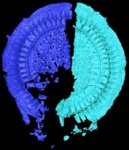The imagery on this page is the basis for a paper entitled The first Ordovician cyclocystoid (Echinodermata) from Gondwana and its morphology, paleoecology, taphonomy, and paleogeography by M. Reich, J. Sprinkle, B. Lefebvre, G.E. Rössner, and S. Zamora (2017, Journal of Paleontology, 91, 735-754). The Abstract is as follows:
Moroccodiscus smithi represents a new cyclocystoid genus and species based on moldic specimens from the Middle Ordovician Taddrist Formation (Darriwilian) of SE Morocco. This represents the earliest articulated member of the Cyclocystoidea and is the first complete cyclocystoid described from the Ordovician of Gondwana, as well as the first cyclocystoid ever recorded from Africa. The anatomy and morphology of this new species were studied using a combination of conventional paleontological methods and nondestructive X-ray computed tomography. Because Moroccodiscus differs from other cyclocystoids, in particular by lacking cupules attached to the marginal
ossicles, it is assigned to the new family Moroccodiscidae. This new taxon illustrates the relatively poorly known early diversification of these enigmatic extinct echinoderms and sheds light on the mode of life of cyclocystoids, including injuries to plate circlets during early ontogeny and folding of these disk-like specimens at the time of death. The overall thecal shape was very similar in cyclocystoids and many domal edrioasteroids, probably because they were both sessile or attached, benthic, suspension feeders. However, many oral surface, ambulacral, and marginal
ring features had become very different, indicating that these two groups had either converged because of similar life modes or were only distantly related sister groups.

About the Species
This specimen was collected from the middle of the Taddrist Formation, Frist Bani Group (upper middle Ordovician) in the Jbel Rhyate region near Tachoate, central eastern Morocco. It was made available to The University of Texas High-Resolution X-ray CT Facility for scanning by Dr. James Sprinkle of The University of Texas at Austin. Funding for scanning was provided by Dr. Sprinkle.

About this Specimen
The specimen was scanned by Matthew Colbert on 21 April 2016 for a total of 986 slices. Voxel size is 62.6 microns.

About the
Scan
None available.

Literature
& Links
Endocast of the specimen segmented to show its folding (left) and digital unfolding (right).

Additional Imagery
 |



 ,
, 






